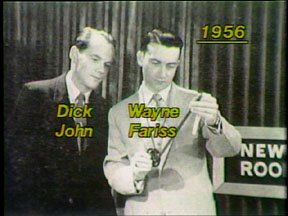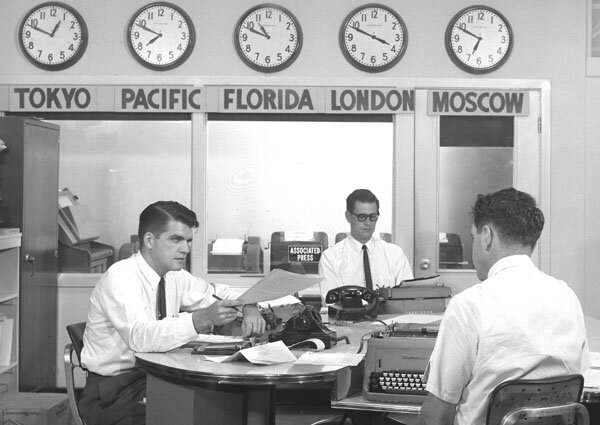A NEW ERA
Channel 13's position as the local leader in news coverage began when the station was purchased by the Gaylord organization in July of 1956. Gaylord added a fleet of station wagons equipped with police-style shortwave radios. 16mm Auricon sound-on-film cameras were purchased, and a more sophisticated film processor was brought down from the home station, WKY-TV, in Oklahoma City.
Dick John, WTVT News Director and Anchor (1956-58)
(Courtesy Dick John)
Another import from WKY-TV, news director Dick John, was charged with hiring reporters and seeing that they were trained as television journalists. John replaced Landis Wilkinson as anchor for the 6pm "Newsroom," and Wayne Fariss continued to anchor the 11p.m. version.
Dick John has kindly written about his days at Channel 13. Click here to read "Newsroom 1956"
The news fleet in 1956.
Standard equipment for the time was the 16mm camera, a microphone, tripod, and small floodlight.
See 'More News Photos' for details on the gear
being used here by Marvin Scott
Reporters such as St. Petersburg bureau chief John Evans had to gauge their time very carefully, since there was no I-275 to whisk them across the Howard Frankland bridge back to the studio in Tampa. In fact, there was no Howard Frankland bridge...just Gandy Bridge. Surface streets were much slower and a reporter had to allow for travel time. During the day, Evans used a scheduled Greyhound bus to send freshly shot newsfilm from downtown St. Petersburg to Tampa, where it would be picked up and brought back to the station for processing.
Evans recalled that on more than a few occasions when breaking news was involved, he would hit the station about the time "Newsroom" was starting. After processing, a few seconds of unedited film would be shown towards the end of the news program.
"Yeah, Chief...I'm in St. Pete. If I leave right now, I'll be back to the studio in 2 hours!"
JACK COSGROVE POSES FOR A PUBLICITY SHOT. THE RADIOPHONE WAS A PROP, AND NOT OPERATING AT THE TIME
Daily reporting usually concluded in the early to mid-afternoon. Once a story was on film, the reporter had to return to the station, and have the film processed.
Earl Wells at the film editing bench
It would then be edited on a 16mm moviola using a hot splicer and glue to join the clips together. A script would be written, checked for accuracy, and the completed film spliced onto a larger reel with other stories scheduled for the evening's news cast. If all went well, the story went out on the air, and the process begun again the next day.
Channel 13's news director and 6pm anchorman, Dick John,
confers with 11pm anchor Wayne Fariss
The need to cover news from Florida's state capitol, Tallahassee, created a need for a bureau there. John Evans was summoned from St. Petersburg to become Channel 13's first Tallahassee bureau chief. Tallahassee is 277 miles from Tampa and a challenging drive in the mid-fifties, before the era of high-speed interstate roads. Getting television news from the state capitol in the days before satellite links proved difficult, but not insurmountable. Newsfilm was taxied daily to the Tallahassee airport where it was given to a flight attendant on a commercial airliner headed to Tampa.
(Mr. Evans has described the early days of reporting from the state capitol for BIG 13. To read John Evan's story, CLICK HERE )
When Dick John was offered a position with WNBC-TV in mid-1958, Gaylord summoned their young news director from the Montgomery station, Crawford Rice, to take over as news director in Tampa. Rice, who doubled as anchor on the 6 o'clock news, hired Joe Loughlin, Ed Herbert, and Earl Wells. The other newsroom regulars of that era were photographer Marvin Scott, announcer and reporter Don Harris, and assignment editor Cy Smith, who joined WTVT in October, 1958.
To learn more about Crawford Rice, link to "A Conversation With Crawford Rice."
Ch. 13 newsroom in 1958. Ed Herbert sits at left, Al Moffat in center,
and Earls Wells at right




